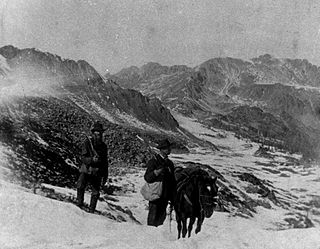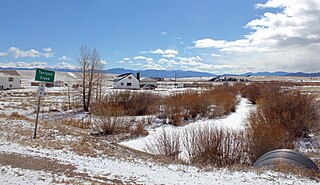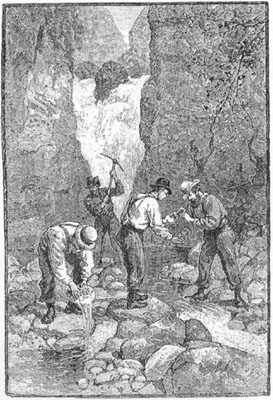Lewis Ralston | |
|---|---|
| Born | 1804 |
| Died | 1870 |
| Occupation(s) | farmer, trader, placer gold prospector, soldier |
| Known for | discovery of gold |
Lewis Ralston was an American placer gold prospector from Georgia who made the first recorded discovery of gold in the Rocky Mountain region. [1] [2]
Lewis Ralston was born in 1804 on a farm in what is now Anderson County, South Carolina. At age 21, he moved to the Cherokee district in the northern part of Georgia, in what is now Lumpkin County. Ralston soon met and went into business with Benjamin Parks, Jr., selling horses and cattle. In 1826, Ralson married Elizabeth Kell, a woman of Cherokee descent, and they moved onto Cherokee land. In 1828, Parks found flakes of gold along a deer path nearby, and the Georgia Gold Rush soon ensued. Ralston panned for gold on his own property with meager results.
On May 28, 1830, President Andrew Jackson signed the Indian Removal Act. Since Ralson was married to a Cherokee woman and lived on Cherokee land, the Act threatened his property. Ralston signed an Oath of Allegiance to the United States, but his property was awarded to Henry Slaughter in a lottery. Ralston purchased a home near the new town Auraria, Georgia.
On January 24, 1848, James W. Marshall found placer gold near Coloma, California, and unbeknownst nine days later, Mexico ceded California and the rest of northern Mexico to the United States with the Treaty of Guadalupe Hidalgo. The California Gold Rush ensued. In the spring of 1850, Ralston joined a wagon train of predominately Cherokee gold prospectors led by John Beck headed to the California gold fields. The party followed the Trail of Tears west, and on June 22, 1850, they crossed the South Platte River (a few miles north of what is today Denver) and camped near the confluence of two streams. Ralston panned for gold near the mouth of the smaller stream (in what is today Arvada.) He found about ¼ troy ounce (8 g) of gold, then worth about five dollars (about $550 USD today.) While Ralston was elated, the rest of the party was unimpressed and continued on to California the next morning. Ralston continued panning for gold, but gave up after a few days and caught up with his party. Ralston had little success in California, and soon returned to his family in Georgia where he settled near Dahlonega.
In 1858, John Beck and William Greeneberry “Green” Russell persuaded Ralston and some others from the original 1850 Cherokee California party to journey back to the site of Ralston's discovery of placer gold in the Pikes Peak Country. On June 24, the party arrived at the site of Ralston’s 1850 discovery, then a part of the Kansas Territory. After five days of futile prospecting, Beck, Ralston, and 45 other men returned to Georgia leaving Green Russell and about a dozen men along the South Platte River. The remaining prospectors ventured up the South Platte River to a site they called Mexican Diggings, which had been prospected by a group of Hispanic prospectors from Taos, New Mexico the previous summer. In July, Green Russel and Sam Bates discovered a small placer deposit of gold at the mouth of Little Dry Creek (in what is today Englewood) that yielded about 20 troy ounces (620 g) of gold, then worth about 380 dollars (about $44,000 USD today.) The party established a camp north of Little Dry Creek that they named Montana City. Some of the party were sent downstream to Omaha to get supplies. Word of the discovery spread quickly and soon precipitated to Pike’s Peak Gold Rush. By the time eager prospectors arrived from Omaha, the diggings at Little Dry Creek had played out and the party had moved downstream to Cherry Creek where they set up a camp named Auraria (named after Auraria, Georgia) to work the Cherry Creek Diggings (at the site of what is today Denver.) Ralston never returned to the Pikes Peak Country.
In 1863, Ralston was inducted into the Confederate Army at age 57. After the war, the Ralston family moved to Dalton, Georgia, where it is believed he died in 1870.
The site of Lewis Ralston's 1850 gold discovery now lies along Ralston Creek in the City of Arvada's Gold Strike Park. Arvada was originally platted in 1870 as the town of Ralston Point, Colorado.
Ralston Creek, Ralston Buttes, Ralston Valley, Ralston Dike, Ralston Reservoir, Ralston Road, Ralston Fields, Ralston Estates, and several other places in Jefferson County, Colorado are named in honor of Lewis Ralston.

The Pike's Peak gold rush was the boom in gold prospecting and mining in the Pike's Peak Country of western Kansas Territory and southwestern Nebraska Territory of the United States that began in July 1858 and lasted until roughly the creation of the Colorado Territory on February 28, 1861. An estimated 100,000 gold seekers took part in one of the greatest gold rushes in North American history.

The City of Idaho Springs is the statutory city that is the most populous municipality in Clear Creek County, Colorado, United States. Idaho Springs is a part of the Denver–Aurora–Lakewood, CO Metropolitan Statistical Area. As of the 2020 census it had a population of 1,782. Idaho Springs is located in Clear Creek Canyon, in the mountains upstream from Golden, some 30 miles (50 km) west of Denver.

Jefferson County is a county located in the U.S. state of Colorado. As of the 2020 census, the population was 582,910, making it the fourth-most populous county in Colorado. The county seat is Golden, and the most populous city's Lakewood.

Arvada is a home rule municipality on the border between Jefferson and Adams counties, Colorado, United States. The city population was 124,402 at the 2020 United States Census, with 121,510 residing in Jefferson County and 2,892 in Adams County. Arvada is the seventh most populous city in Colorado. The city is a part of the Denver–Aurora–Lakewood, CO Metropolitan Statistical Area and the Front Range Urban Corridor. The Olde Town Arvada historic district is 7 miles (11 km) northwest of the Colorado State Capitol in Denver.

The region that is today the U.S. State of Colorado has been inhabited by Native Americans and their Paleoamerican ancestors for at least 13,500 years and possibly more than 37,000 years. The eastern edge of the Rocky Mountains was a major migration route that was important to the spread of early peoples throughout the Americas. The Lindenmeier site in Larimer County contains artifacts dating from approximately 8720 BCE.

The Territory of Colorado was an organized incorporated territory of the United States that existed from February 28, 1861, until August 1, 1876, when it was admitted to the Union as the State of Colorado.

Auraria is a ghost town in Lumpkin County, Georgia, United States, southwest of Dahlonega. Its name derives from aurum, the Latin word for gold. In its early days, it was also known variously as Dean, Deans, Nuckollsville, and Scuffle Town.

Auraria was a small mining settlement in the Kansas Territory in the United States. Today it survives in its original location as a neighborhood of Denver, Colorado, south of the confluence of Cherry Creek and the South Platte River.

Ralston Creek is a tributary of Clear Creek, approximately 32 miles (51 km) long, in central Colorado in the United States. It drains a suburban and urban area of the northwestern Denver Metropolitan Area. It rises in the foothills in northeastern Gilpin County, in southern Golden Gate Canyon State Park. It descends through a valley eastward into Jefferson, following Drew Hill Road, emerging from the mountains approximately 3 miles (5 km) north of Golden, where it is impounded to form Ralston Reservoir and Arvada/Blunn Reservoir on both sides of State Highway 93. It flows eastward through Arvada and joins Clear Creek from the north in southeast Arvada, near the intersection of Sheridan Avenue and Interstate 76.

Tarryall Creek is a tributary of the South Platte River, approximately 68.5 miles (110.2 km) long, in Park County in central Colorado in the United States. It drains a rural portion of north and central South Park, an intermontane grassland in the Rocky Mountains southwest of Denver. It rises in the high Rockies in several forks along the Continental Divide in the Pike National Forest southwest of Boreas Pass. It descends to the southwest through a short canyon, emerging into South Park near Como, Colorado. It crosses U.S. Highway 285 east of Red Hill Pass northeast of Fairplay, the county seat of Park County, then meanders towards the southeast, joining the South Platte from the east in the southeastern corner of South Park.

The Cherokee Trail was a historic overland trail through the present-day U.S. states of Oklahoma, Kansas, Colorado, and Wyoming that was used from the late 1840s up through the early 1890s. The route was established in 1849 by a wagon train headed to the gold fields in California. Among the members of the expedition were a group of Cherokee. When the train formed in Indian Territory, Lewis Evans of Evansville, Arkansas, was elected Captain. Thus, this expedition is sometimes written as the Evans/Cherokee Train. In 1850 four wagon trains turned west on the Laramie Plains, along Wyoming's southern border to Fort Bridger.

Montana City was the first settlement in what was later to become Denver, Colorado. It was established during the Pikes Peak Gold Rush on the east bank of the South Platte River, just north of the confluence with Little Dry Creek, in 1858. At the time, the site was in the Kansas Territory.

The Georgia Gold Rush was the second significant gold rush in the United States and the first in Georgia, and overshadowed the previous rush in North Carolina. It started in 1829 in present-day Lumpkin County near the county seat, Dahlonega, and soon spread through the North Georgia mountains, following the Georgia Gold Belt. By the early 1840s, gold became difficult to find. Many Georgia miners moved west when gold was found in the Sierra Nevada in 1848, starting the California Gold Rush. Since the 16th century, American Indians in Georgia told European explorers that the small amounts of gold which they possessed came from mountains of the interior. Some poorly documented accounts exist of Spanish or French mining gold in North Georgia between 1560 and 1690, but they are based on supposition and on rumors passed on by Indians. In summing up known sources, W.S. Yeates observed: "Many of these accounts and traditions seem to be quite plausible. Nevertheless, it is hardly probable that the Spaniards would have abandoned mines which were afterwards found to be quite profitable, as those in North Georgia."
William Greeneberry "Green" Russell (1818–1877) was an American gold prospector and miner.
Gold mining in Colorado, a state of the United States, has been an industry since 1858. It also played a key role in the establishment of the state of Colorado.

Russell Gulch, is a former mining town, now largely a ghost town, in Gilpin County, Colorado, United States. Although the population was once much larger than today, and most of the larger commercial buildings stand empty, the town is not completely deserted.
Tarryall is a ghost town in northwest Park County, Colorado, United States. It is on upper Tarryall Creek northwest of Como, Colorado. It was once the county seat of Park County, but is now completely deserted.

The G Line, also known as the Gold Line during construction, is a Regional Transportation District (RTD) electric commuter rail line between Denver Union Station and Wheat Ridge, Colorado. Long scheduled to open in October 2016, the opening was delayed until mid-2019. The reason specified for the delay was timing issues experienced by the other commuter rail lines in the RTD system, which currently require a Federal Railroad Administration waiver to operate their grade crossings manually, and the wireless crossing system used by those lines.
Jimmy's Camp was a trading post established in 1833. The site is east of present-day Colorado Springs, Colorado on the southeast side of U.S. Route 24 and east of the junction with State Highway 94. Located along Trapper's Trail / Cherokee Trail, it was a rest stop for travelers and was known for its spring. Jimmy Camp was a ranch by 1870 and then a railway station on a spur of the Colorado and Southern Railway. After the ranch was owned by several individuals, it became part of the Banning Lewis Ranch. Now the land is an undeveloped park in Colorado Springs.
Henry Allen was an American pioneer and politician. He served in the United States Army before settling in Council Bluffs, where he was a postmaster. He was at the front of the Pike's Peak Gold Rush, arriving in Denver of the Kansas Territory in October 1858. He prospected for gold and was the first official postmaster of the Pikes Peak region. As a surveyor, he helped establish Auraria, Highland, which later came part of the city of Denver. He was a founder of a company that diverted water from the South Platte River through irrigation ditches. He held the first meeting in his cabin for what became the Auraria Masonic Lodge. He was a delegate from Auraria for the first Constitutional Convention of the Jefferson Territory. Allen and his wife lived in mining towns in Colorado, Idaho, and Montana. Due to poor health, Henry and Susan Allen moved to California, where Allen died in 1871.